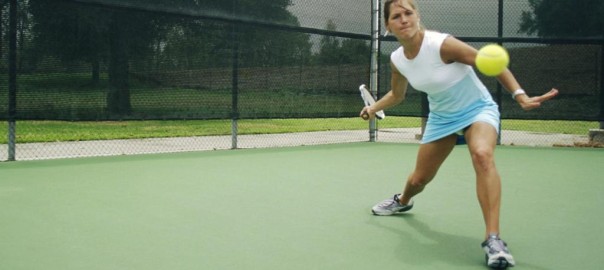If You Play Tennis – You Need To Read This

There is good news for people suffering from debilitating lateral epicondylitis, commonly known as tennis elbow. This condition, so named because it is often a significant problem for tennis players, is the result of overusing the forearm muscles. This overuse leads to injury of the tendon that lies on the outer side of the elbow. Symptoms include pain that is worsened by shaking hands, squeezing things, lifting objects, opening jars, and using tools or utensils like a knife or toothbrush.
About 50 percent of professional tennis players will suffer from tennis elbow at some point in their career, but in the general population, less than 5 percent of cases are the result of actually playing tennis. People participating in activities that require repetitive movements of the forearm or tightly gripping objects in the hand are particularly susceptible, such as golfers, gardeners, cleaners, carpenters, and assembly line workers. The condition can affect anyone, but men in the 30-50 age group are affected most often.
Conservative treatment for tennis elbow consists of rest and avoiding the provoking activity. Application of ice can help, as can bracing. The pain can be symptomatically addressed with nonsteroidal anti-inflammatory medications (NSAIDs, e.g., ibuprofen). Either topical application or injection of cortisone medications may be attempted. In particularly severe and unresponsive cases, surgery is the last resort to repair the muscle-tendon unit in the elbow.
A study published in the American Journal of Sports Medicine reports another effective treatment in which a special preparation of the patient’s own blood is injected into the elbow tendon. Platelet-rich plasma (PRP) therapy is a novel biologic treatment in which highly concentrated platelets (more than 500 percent richer) packed with growth factors are used to treat injured tissue in patients who have failed to respond to commonly used therapies. Unlike muscles, which have an abundant blood supply, the rope-like tendons in the human body have relatively poor blood flow, hindering their repair. PRP therapy works by promoting healing of the degenerated tendon and supporting the body in its natural restorative process.
The study looked at 140 patients with severe pain from tennis elbow lasting more than 3 months, in whom rest, physical therapy, NSAIDs, and cortisone shots had failed to yield results. Strict criteria were then used to select 20 patients with the most severe tendonitis, and 15 of them received a single injection of platelet-rich plasma into the affected tendon. The control group of 5 patients received an injection of local anesthetic instead. Both groups underwent a similar stretching and physical therapy program that began two weeks after the injection. Following a return to normal activities, the study subjects were evaluated at 1, 2, and 6-month intervals following treatment. At every evaluation, the group treated with PRP reported a far greater improvement in symptoms compared to the control group. Even two years out from the injection, more than 90 percent of the PRP group reported complete satisfaction with the treatment and pain-free return to work and sports.
The study authors postulate that powerful growth factors in the plasma initiate repair of the damaged tendon and draw other cells to the area to speed up the process. Platelet-rich plasma therapy captures the body’s extraordinary ability to repair itself, and this means that tennis elbow sufferers may no longer need surgery to obtain pain relief.
References:
http://www.eurekalert.org/pub_releases/2006-10/aosf-nbt101606.php
http://www.webmd.com/osteoarthritis/guide/tennis-elbow
Image courtesy of http://www.clubphysioplus.com/


